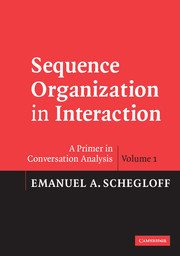Book contents
- Frontmatter
- Contents
- Preface
- Acknowledgments
- 1 Introduction to sequence organization
- 2 The adjacency pair as the unit for sequence construction
- 3 Minimal, two-turn adjacency pair sequences
- 4 Pre-expansion
- 5 The organization of preference/dispreference
- 6 Insert expansion
- 7 Post-expansion
- 8 Topic-proffering sequences: a distinctive adjacency pair sequence structure
- 9 Sequence-closing sequences
- 10 Sequences of sequences
- 11 Retro-sequences
- 12 Some variations in sequence organization
- 13 Sequence as practice
- 14 Summary and Applications
- Appendix 1 Conversation-analytic transcript symbols
- Appendix 2 Transcript of a telephone call
- References
- Index
12 - Some variations in sequence organization
Published online by Cambridge University Press: 05 September 2012
- Frontmatter
- Contents
- Preface
- Acknowledgments
- 1 Introduction to sequence organization
- 2 The adjacency pair as the unit for sequence construction
- 3 Minimal, two-turn adjacency pair sequences
- 4 Pre-expansion
- 5 The organization of preference/dispreference
- 6 Insert expansion
- 7 Post-expansion
- 8 Topic-proffering sequences: a distinctive adjacency pair sequence structure
- 9 Sequence-closing sequences
- 10 Sequences of sequences
- 11 Retro-sequences
- 12 Some variations in sequence organization
- 13 Sequence as practice
- 14 Summary and Applications
- Appendix 1 Conversation-analytic transcript symbols
- Appendix 2 Transcript of a telephone call
- References
- Index
Summary
Although the account of sequence structure built on the underlying resource of the adjacency pair has considerable scope and robustness, it should not be understood as an inflexible template which mechanically generates “parts” assigned to various participants. Rather it should be understood as an organizational resource – a kind of convergently oriented-to set of possible routes – which the participants draw on in charting and incrementally building a joint course of action.
There is, then, an underlying range of orderly structures and a set of practices for suiting those structures to the particulars of the moment in which the participants are acting. Because sequences are a major resource in implementing courses of action, we should expect their forms and trajectories to reflect (among other sources of variation) the contingencies of the courses of action being pursued through them. And because particular settings may be the site of distinctive activities and courses of action, variants of the sequence organization and practices we have been describing may show up with special clarity in “specialized settings,” whether specialized by virtue of the work which gets done in them (which will be our focus here) or by reference to other characteristics (e.g., the population which they specially mobilize and their interaction-relevant characteristics, the non-work activities specially pursued there, etc.).
This is not a vapid and shapeless “adaptation to context,” not an undisciplined “anything will do,” or “anything goes.”
- Type
- Chapter
- Information
- Sequence Organization in InteractionA Primer in Conversation Analysis, pp. 220 - 230Publisher: Cambridge University PressPrint publication year: 2007

